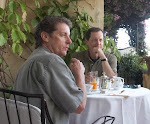 Siena is historically most famous for its long, valiant struggle to remain independent of its aggressive and powerful neighbor to the north, Florence (or rather Firenze … “Florence” is just the name early British visitors gave the Tuscan capital city because they were tired of trying to pronounce its actual name). Siena got in some good punches, but ultimately lost its independence, succumbing to Florentine rule in 1555.
Siena is historically most famous for its long, valiant struggle to remain independent of its aggressive and powerful neighbor to the north, Florence (or rather Firenze … “Florence” is just the name early British visitors gave the Tuscan capital city because they were tired of trying to pronounce its actual name). Siena got in some good punches, but ultimately lost its independence, succumbing to Florentine rule in 1555. Both cities are Tuscan, both are surrounded by vast grape vineyards and olive orchards, both are cities of higher learning and of fine arts, and both became famous in history for moving away from the domination of the Catholic Church in Rome. These were “civil” cities, that, to the extent possible, separated church and state in the same way we understand those terms in the United States today. Roman Catholicism never ceased to be “the” religion of choice in both cities, but the Medici dynasty in Florence, and the noble families of Siena (like the famous Piccolomini family) refused to accept that the Pope should dictate public policy in addition to religious practices. The great families of Siena made this a formal proclamation of independence from the Church in 1167, an act that Madrid or Paris, for example, would have found unthinkable at that time in history.
Accordingly, in Siena, the great “square” (the “Campo” … one of the most famous plazas in Europe) is dominated not by a great cathedral, but rather the high tower of the city’s civil government offices.
 The great Duomo of Siena is not far away, with its own comparatively cramped plaza. One look at the Duomo of Siena, though, tells the other side of the story. Ousted from civil dominance, the Church still put on quite a show with this amazing structure. To walk into the cathedral of Siena is to be overcome with the sense of power those long-robed cardinals wielded for centuries in this city. High above, visitors can’t help noticing the sculpted heads of the first172 popes staring down at them. “Have your own way, but remember, we’re watching you!”
The great Duomo of Siena is not far away, with its own comparatively cramped plaza. One look at the Duomo of Siena, though, tells the other side of the story. Ousted from civil dominance, the Church still put on quite a show with this amazing structure. To walk into the cathedral of Siena is to be overcome with the sense of power those long-robed cardinals wielded for centuries in this city. High above, visitors can’t help noticing the sculpted heads of the first172 popes staring down at them. “Have your own way, but remember, we’re watching you!”








